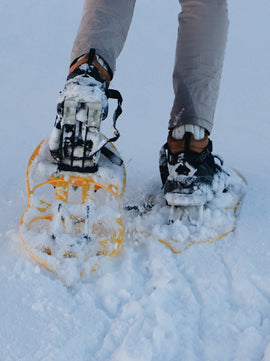Skiers, snowshoers, or any outdoor enthusiasts need to be on top of their kit whether they’re going up, down, or just around town.
Mastering how to layer helps you regulate your body temperature and stay dry so you can have the most fun possible no matter where your adventure takes you –from hiking or running, to frigid skiing days.
In this layering guide, we'll walk you through the three different types of clothing layers—the base layer, mid layer, and outer layer—and show you how to dial in your kit like a pro.
How to Choose Base Layer Clothing
When choosing base layers to wear consider these three factors: the material, the weight, and your personal preferences.
For the best base layer materials, merino wool base layers, synthetic fabrics, and blends of both stand above the rest.
1. Merino wool base layers are known for natural odor resistance, moisture management capabilities, and regulating body temperature thanks to its breathability.
2. Synthetic base layers are also known for their breathability and moisture-wicking capabilities, but offer a quick-dry and lightweight substitute to Merino wool.
3. Wool blend base layers combine the natural advantages of wool with the adaptability of synthetic materials for the best of both worlds.
PRO TIP: Cotton should never be used as a base layer particularly in backcountry pursuits. It holds moisture next to the body. This means you’ll feel damp and clammy during frigid days, which can lead to hypothermia.
How to Choose Mid Layer Clothing
When choosing the best mid layer, it’s ultimately up to your preference and the right material for the weather and activity.
1. Goose down mid layers offer the highest quality natural insulation and the best warmth-to-weight ratio with its fluffy, yet lightweight, breathable, and packable features. Because of their packability, down jackets are easy to bring along, allowing you to add or shed them during changing conditions or outputs. Down can also double as a mid or outer layer.
2. Fleece mid layers are also popular due to their softness, versatility, and breathability. Plus you can find your fleece layers in just about any style and color imaginable.
3.Synthetic insulation mid layers are best known for their breathability and ability to insulate even when wet, unlike down insulation. Synthetic insulation is often more heavy-weight and less packable than down, but is also used for mid or outer layering.
How to Choose Windproof and Waterproof Jackets and Pants
Windproof and waterproof jackets and pants are outer layer essentials. To choose your outer layer, you can choose from hard or soft shells.
Windproof and waterproof hardshells are durable and shield you from the elements. Hardshells keep you dry on the outside and can breath so moisture caused by heat can escape. GORE-TEX is the gold standard in waterproof and breathable hard-shells.
Softshell outer layers offer comfort and breathability at the expense of waterproofing. Softshells are less wind and water-resistant than hardshells, but many have a durable water repellent (DWR) finish that can keep you dry if a quick storm blows in.
Combination outdoor jackets for 3-in-1 jackets with windproof, waterproof, and removable down, synthetic, or fleece insulation. These jackets are great for resort skiing and snowboarding when the weather can change throughout the day and you need a simple layering solution.
PRO TIP: Look for features like adjustable hoods, pit zips, and waterproof zippers for added convenience and protection.

